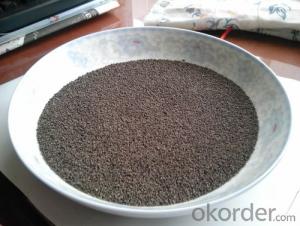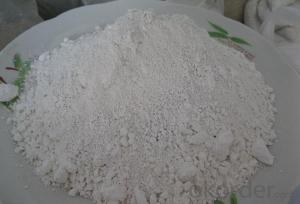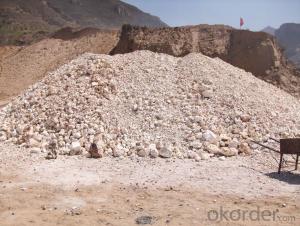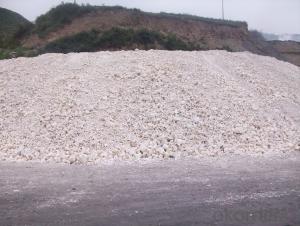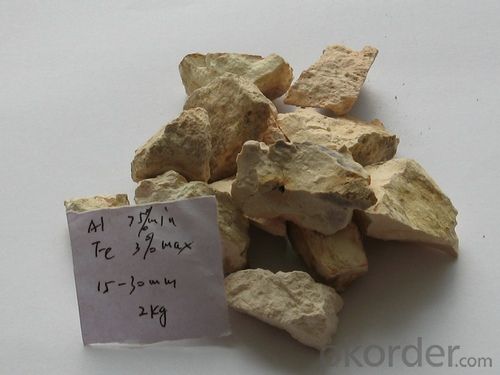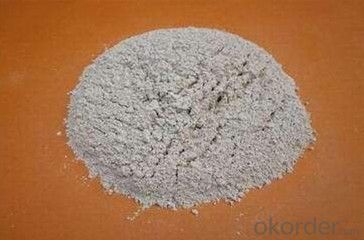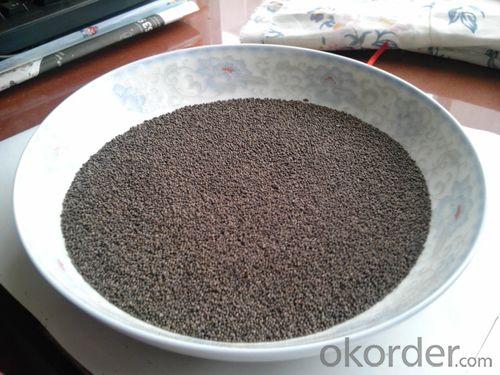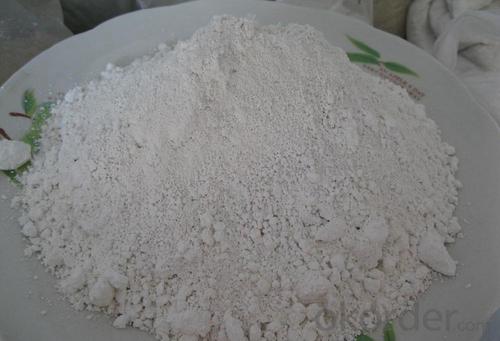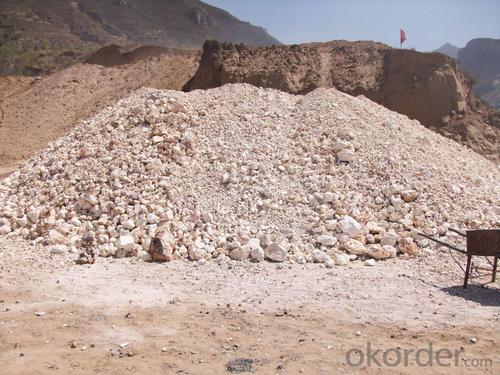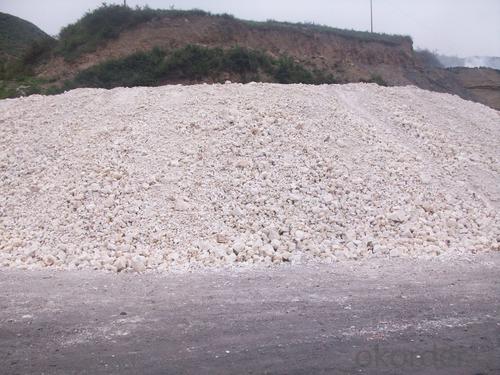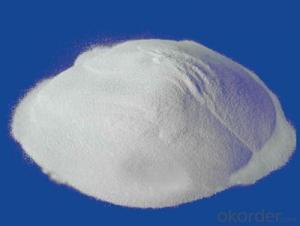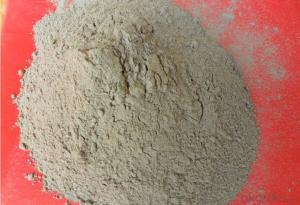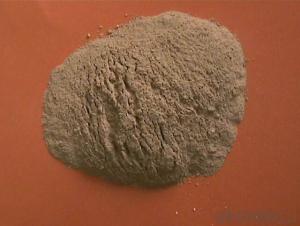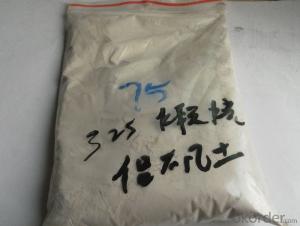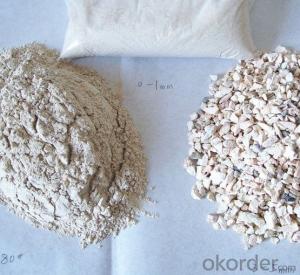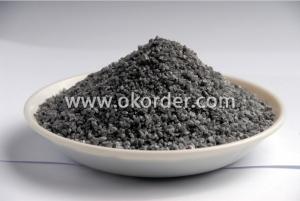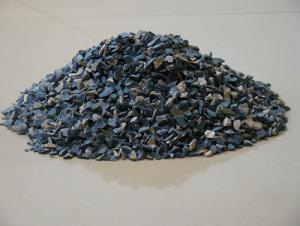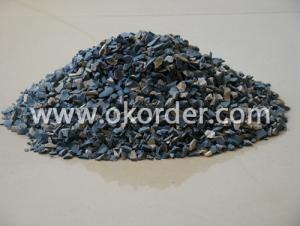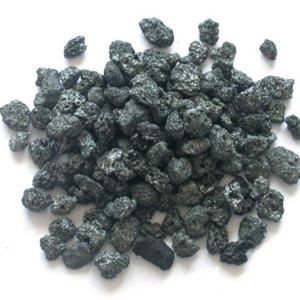Raw Materials for Refractory:76% Rotary/Shaft/Round Kiln Alumina Calcined Bauxite
- Loading Port:
- Tianjin
- Payment Terms:
- TT or LC
- Min Order Qty:
- 25 m.t.
- Supply Capability:
- 3000 m.t./month
OKorder Service Pledge
OKorder Financial Service
You Might Also Like
76% Rotary/ Shaft/ Round Kiln Alumina Calcined Bauxite Raw Material for Refractory
Introduction
Calcined bauxite is one of the principal ore of aluminum. Calcined bauxite contains hydrous aluminum oxides and aluminum hydroxides, formed through the laterization of aluminous rocks in tropical and subtropical areas .calcined bauxite is obtained by calcining (heating)superior grade bauxite at high temperature (from 85OC to 1600C) .this removes moisture thereby increasing the alumina content. compared to an alumina content of about 57%to 58%in raw bauxite, calcined bauxite has an alumina content of 84%to88%.the heating is carried out in rotary kilns
1.Applications
Raw bauxite is typically classified according to its intended commercial application,such as abrasive ,cement ,chemical, metallurgical, and refractory .as raw material for use in high alumina and super duty refractory bricks and shapes ,plastics ,castable refractory, motors, gun mixes, ramming mixes, abrasive grains and other products.
2.specifications
Item | Al2O3 | Fe2O3 | TiO2 | K2O+Na2O | CaO+MgO | Bulk density |
GAL65 | ≥65 | ≤2.5 | ≤4.0 | ≤0.3 | ≤0.5 | ≥2.6 |
GAL75 | ≥75 | ≤2.5 | ≤4.0 | ≤0.3 | ≤0.5 | ≥2.7 |
GAL80 | ≥80 | ≤2.5 | ≤4.0 | ≤0.3 | ≤0.5 | ≥2.8 |
GAL85 | ≥85 | ≤2 | ≤4.0 | ≤0.3 | ≤0.5 | ≥3.0 |
GAL86 | ≥86 | ≤2 | ≤4.0 | ≤0.3 | ≤0.5 | ≥3.1 |
GAL87 | ≥87 | ≤2 | ≤4.0 | ≤0.3 | ≤0.5 | ≥3.2 |
GAL88 | ≥88 | ≤1.8 | ≤4.0 | ≤0.25 | ≤0.5 | ≥3.25 |
GAL90 | ≥90 | ≤1.8 | ≤4.0 | ≤0.25 | ≤0.5 | ≥3.25 |
Calcined Bauxite Grade:
1.Refractory Grade: |
Refractory grade bauxite has high refractoriness, good mechanical strength and moderate slag resistance. Bauxite in the refractory industry is typically used in ladle working lining, tundish furniture, delta sections, general perpose repairment, aluminium melting furnace and mineral processing.
3. Rotary calcined bauxite: |
Rotary Kiln Bauxite, as the name suggests, it is the bauxite produced by rotary kiln. there are three kinds of kilns for bauxite production mainly, rotary kiln, shaft kiln and round kiln.
4. Shaft kiln calcined bauxite: |
Shaft kiln bauxite, the bauxite calcined by shaft kiln. the raw material-bauxite ore is loaded from the top of kiln together with coal powder and combustion improver,the fire of calcination comes from kiln bottom, about 1300-1400 ℃After the complete calcination, the bauxite is carried out from the bottom.
Packaging & Delivery
Packaging Details: In bulk or in 1-1.25mr bag
Product Pictures:

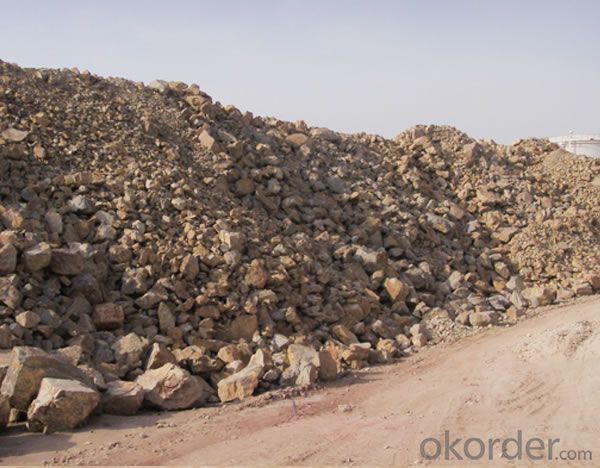
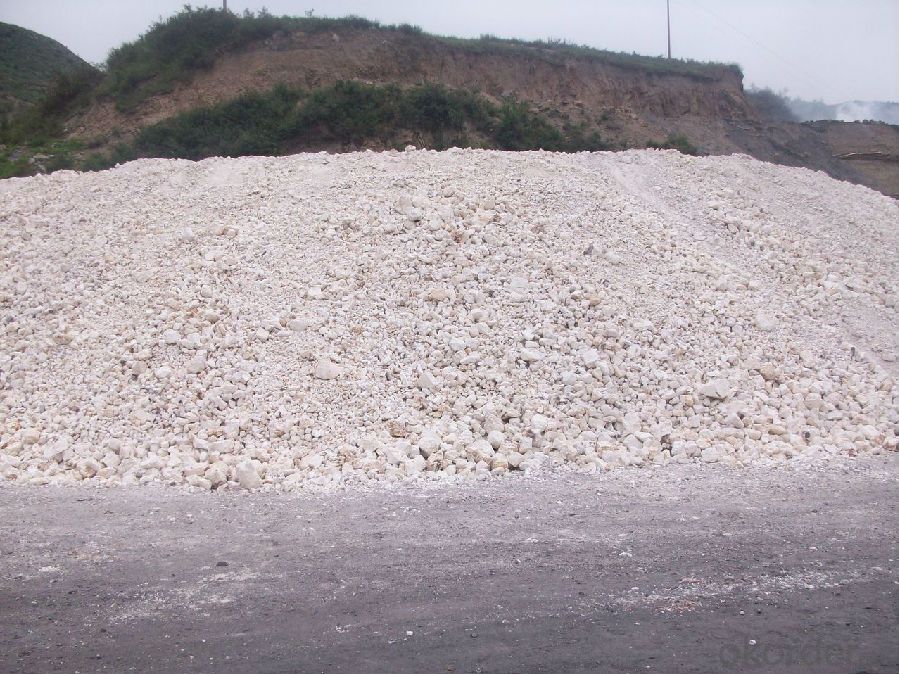
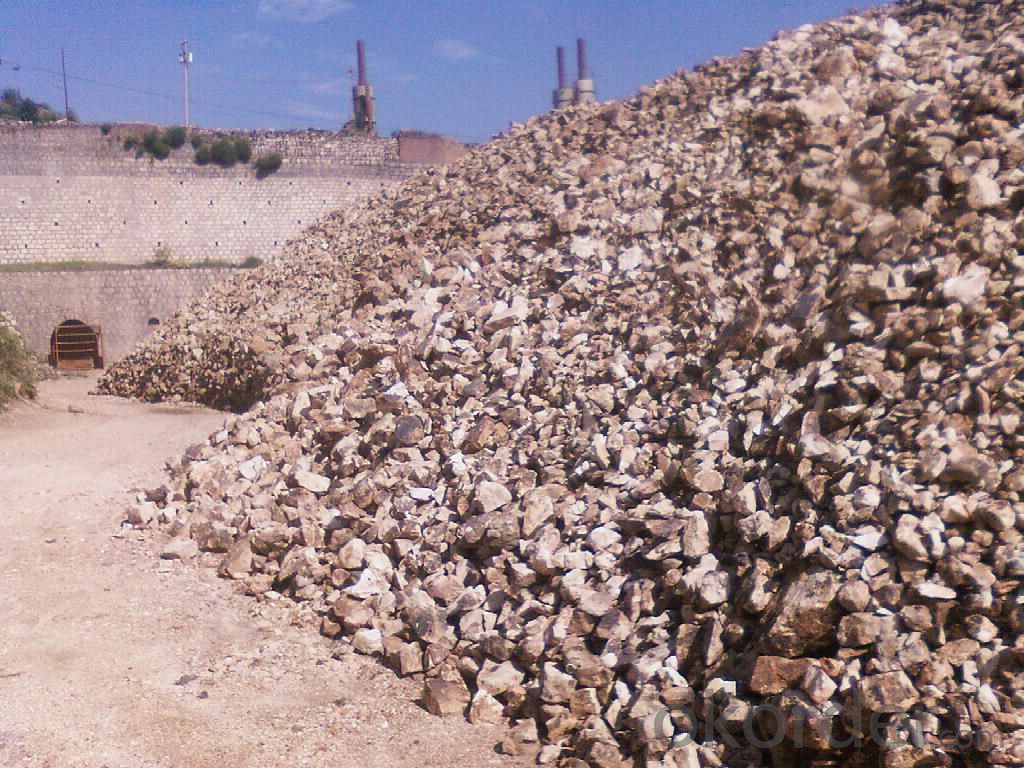
Our Service:
1. Your inquiry related to our products or prices will be replied in 24hours.
2. Manufacturer with large capacity, ensure the fast production cycle after confirmed the order.
3. Our professional technicians will answer your entire enquiry in patient.
4. To meet the refractory solutions, we can serve as your instructions.
5. Protection of sales area and private information for our entire customer.
If you’ve kind enquiries, please don’t hesitate to let us know. ^_^
- Q: Does the external wall thermal insulation materials level b1 need the fire barrier zone?
- First, it is prohibited that the thermal insulation material of level B2 and below combustion performance is used in the thermal insulation project of any civil building wall, and the thermal insulation material of below level A combustion performance is used in the thermal insulation project of curtain wall civil builduing that the height is equal and greater than 24m, of non-curtain wall residential building that the height is equal and greater than 100m and of other non-curtain wall civil builduing that the height is is equal and greater than 50m. Civil builduing wall thermal insulation project must strictly enforce the "civil builduing external wall thermal insulation systems and external wall decoration fireproofing interim provisions" (referred to as "fireproofing interim provisions").
- Q: How many kinds of A-level fireproof and thermal insulation materials are there?
- 1. foam insulation board refers to foam ceramic insulation panels whose raw material is inorganic ceramic which is calcinated at high temperature with abbreviation of ceramic insulation board 2.Composite cement foam insulation board is a hydrophobic lightweight closed-cell insulation board whose main materials are cement, fly Ash, and silica fume which has been foamed, cured and cut. 3. aerated concrete panel is a lightweight concrete panel which has been autoclaved with lightweight materials, siliceous material and gas former as its raw materials. 4. rock wool panel, with natural igneous rock wool as its main raw material, is a cotton which is melted in high temperature by centrifugation and is pasted by thermosetting resin.
- Q: How to prolong the furnace age of Induction furnace by using fireproof materials?
- magnesia solid materials have thermal endurance and erosion/ performance and its change of temperature is likely to cause cracks. properties of materials (aluminum) in such case have to be taken into consideration.
- Q: What is the appropiate thickness if fire resistant time for ultra thin steel structure coating is 2.5 hours?
- Hello steel structure can adopt surrounding concrete or brick, fireproof coating, fireproof board coating and composite structure for its fire resisitance. Fire resisitance board can be divided into thick fire protection plate and thin plate, the thickness of the plate thickness of the fire is between 20 ~ 50mm, mainly includes calcium silicate fireproof board and expansion boring stone fire board, the main varieties are KB board, CF; thin fireproof plate is between 6 ~ 15mm thick, the main varieties include enforced short fiber cement plate, ordinary enforced fiber silicate calcium board and glass cloth reinforced inorganic board.
- Q: Who knows that among refractory materials, insulation boards from which refractory material industry is superior in quality?
- When casting ingot, after high temperature molten steel is poured into ingot mold, molten steel keeps shrinking during cooling, for example, killed steel is shrinking 3% --5%. because of fast heat dissipation of ingot head , some shrinkage holes appear at the head of ingot. Therefore, you should cut shrinkage holes which account for more than 15% of the ingot quality in the head while cutting steel ingot cogging. If effective measures were taken to insulate the head of ingot from heat, then the coagulation time of ingot head would lag behind in the body of the ingot solidification, which will greatly shrinkage holes, improve ingot yield so as to reduce energy consumption of steelmaking. Adiabatic plate can achieve this purpose. China Heng insulation board has the advantages of uplifting adiabaticity and small heat capacity, so that it greatly reduced heat loss of molten steel, And the tundish can be directly put into use without preheating, thereby saving a large amount of preheating fuel. So in the current process of continuous casting, the heat insulation board is the main material of tundish lining.
- Q: What is the acceptance standard of refractory?
- Feeler gauge is used to check the thickness of the refractory brickwork joint. The top of the gauge can not be sharpened. Feeler gauge is of the width of 15mm, length of 100mm and thickness of 1, 1.5, 2 or 3mm. The thickness is eligible when the depth which the feeler gauge is inserted in is less than or equal to 20mm. Ten places should be inspected per 5m2 of masonry surfaces. It is qualified when the condition in which thickness of the brickwork joint is 50% larger than a predetermined depth is not less than five times and it is excellent when the condition is no more than two times.
- Q: What kind of refractory bricks material is best?
- 1, high alumina brick: The content of Al2O3 is more than 75. The refractoriness is higher than the clay brick. It has good resistance to acid, alkali and erosion and is suitable for cement kiln calcining zone and other places. It has long operation life, but the price is high. 2. dolomite?brick: Formation of coating has good performance, good corrosion resistance, but f-CaO is contained in bricks. It is hydratable and difficult to transport and keep, so it is less used in the production. 3. magnesia-chrome bricks: It has good formation of coating and is used for burning zone. The disadvantage is poor thermal shock resistant performance. Besides, positive Hexavalent Cr is highly toxic. Countries that produce and use magnesia-chrome bricks gradually decrease on the international. Now production units using this brick should find alternatives as soon as possible. 4. spinel brick: It is often used in transitional zone and has good seismic performance, good reduction resistance, but refractoriness is a little bit poor. 5. anti-stripping brick: This brick contains a small amount of ZrO. Martensite phase transformation happens to form thin crack during temperature-rise period. It has strong alkali?resistance, anti-stripping performance and good slag resistance. 6. phosphate brick: It has low refractoriness, but it has strong strength and good shock resistance. It is often used in grate?cooler, hot kiln hood, etc. 7. carborundum brick: It has high temperature resistance(1800 degree, softening temperature under a fixed load is 1620-1640), small coefficient of thermal expansion, high cold-resistance heat-resistance, abrasion resistance. It is suitable for cooling zone and kilneye. 8. silmo brick: It has good thermal shock resistance, high strength, good abrasion resistance, and is suitable for transitional belt.
- Q: Does anyone know about the A-level fireproof materials?
- A-level decorative integrated plates of thermal insulation, water- and fire-proofing mainly can prevent fire and insulate heat with A-level fireproofing glass fiber as thermal insulation materials. The classification of A1-level external wall materials of thermal insulation, fire- and water-proofing: First, external wall thermal insulation materials: 1. silicate?thermal?insulation?materials 2. gelatine powder polyphenyl granules 3. steel wire gauze picking cement cystosepiment (grs board) 4. extruded sheets; Second, roofing materials: 1. xps extruded sheet 2. EPS foam board 3. perlite and perlite brick 4, vermiculite and vermiculite bricks; Third, heating and air conditioning materials: Polyurethane, rubberplastic sponge, polyethylene, polystyrene foam, glass wool, rock wool; Four, steel structure materials: Polystyrene, extruded sheet, Polyurethane board, glass wool roll mat, etc.
- Q: what are the types of piping insulation material fire?rating?
- Pipe insulation material Fire rating: heat conductivity coefficient(at room temperature) 0.025 grade non-combustible Class A low temperature bending ≤ 5000 breaking elongation 5,000 specifications 5000 anti-bending?strength 5000 compressive?strength 5000 special brand of high use temperature -250 ~ 150 ℃ core material, phenolic foam, form, stratiform, shape,flake.
- Q: Are refractory materials and fireproofing materials the same?
- Refractory materials is flammable when it is reached certain temperature for a certain time, but it will not support burning when there is no open fire (such as: gypsum board). Fireproofing material reaches A grade and it is non-combustible itself.
Send your message to us
Raw Materials for Refractory:76% Rotary/Shaft/Round Kiln Alumina Calcined Bauxite
- Loading Port:
- Tianjin
- Payment Terms:
- TT or LC
- Min Order Qty:
- 25 m.t.
- Supply Capability:
- 3000 m.t./month
OKorder Service Pledge
OKorder Financial Service
Similar products
Hot products
Hot Searches
Related keywords


